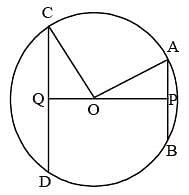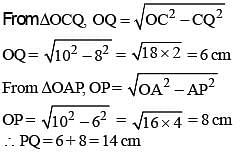SSC CGL Exam > SSC CGL Questions > Two parallel chords of a circle, of diameter ...
Start Learning for Free
Two parallel chords of a circle, of diameter 20 cm lying on the opposite sides of the centre are of lengths 12 cm and 16 cm.
The distance between the chords is (SSC CGL 1st Sit. 2013)
The distance between the chords is (SSC CGL 1st Sit. 2013)
- a)16cm
- b)24cm
- c)14 cm
- d)20 cm
Correct answer is option 'C'. Can you explain this answer?
| FREE This question is part of | Download PDF Attempt this Test |
Verified Answer
Two parallel chords of a circle, of diameter 20 cm lying on the opposi...

OA = OC = 10 cm (radius)
AB = 12 cm
AP = PB = 6 cm
CD = 16 cm
CQ = QD = 8 cm

Most Upvoted Answer
Two parallel chords of a circle, of diameter 20 cm lying on the opposi...
Given information:
- Diameter of the circle = 20 cm
- Length of one chord = 12 cm
- Length of another chord = 16 cm
Approach:
To find the distance between the chords, we need to find the height of the trapezium formed by the chords.
Solution:
Step 1: Finding the radius of the circle
The diameter of the circle is given as 20 cm. The radius of the circle is half of the diameter.
Radius = Diameter/2 = 20/2 = 10 cm
Step 2: Finding the distance of each chord from the center of the circle
The distance of each chord from the center of the circle is equal to the perpendicular distance of the chord from the center.
Using the Pythagorean theorem, we can find this distance.
For the chord of length 12 cm:
Distance = √(r^2 - (l/2)^2) = √(10^2 - (12/2)^2) = √(100 - 36) = √64 = 8 cm
For the chord of length 16 cm:
Distance = √(r^2 - (l/2)^2) = √(10^2 - (16/2)^2) = √(100 - 64) = √36 = 6 cm
Step 3: Finding the height of the trapezium
The height of the trapezium is the difference between the distances of the chords from the center.
Height = Distance of longer chord - Distance of shorter chord = 8 - 6 = 2 cm
Therefore, the distance between the chords is 2 cm, which is not one of the given options. Hence, none of the provided options is correct.
Attention SSC CGL Students!
To make sure you are not studying endlessly, EduRev has designed SSC CGL study material, with Structured Courses, Videos, & Test Series. Plus get personalized analysis, doubt solving and improvement plans to achieve a great score in SSC CGL.

|
Explore Courses for SSC CGL exam
|

|
Similar SSC CGL Doubts
Two parallel chords of a circle, of diameter 20 cm lying on the opposite sides of the centre are of lengths 12 cm and 16 cm.The distance between the chords is (SSC CGL 1st Sit. 2013)a)16cmb)24cmc)14 cmd)20 cmCorrect answer is option 'C'. Can you explain this answer?
Question Description
Two parallel chords of a circle, of diameter 20 cm lying on the opposite sides of the centre are of lengths 12 cm and 16 cm.The distance between the chords is (SSC CGL 1st Sit. 2013)a)16cmb)24cmc)14 cmd)20 cmCorrect answer is option 'C'. Can you explain this answer? for SSC CGL 2024 is part of SSC CGL preparation. The Question and answers have been prepared according to the SSC CGL exam syllabus. Information about Two parallel chords of a circle, of diameter 20 cm lying on the opposite sides of the centre are of lengths 12 cm and 16 cm.The distance between the chords is (SSC CGL 1st Sit. 2013)a)16cmb)24cmc)14 cmd)20 cmCorrect answer is option 'C'. Can you explain this answer? covers all topics & solutions for SSC CGL 2024 Exam. Find important definitions, questions, meanings, examples, exercises and tests below for Two parallel chords of a circle, of diameter 20 cm lying on the opposite sides of the centre are of lengths 12 cm and 16 cm.The distance between the chords is (SSC CGL 1st Sit. 2013)a)16cmb)24cmc)14 cmd)20 cmCorrect answer is option 'C'. Can you explain this answer?.
Two parallel chords of a circle, of diameter 20 cm lying on the opposite sides of the centre are of lengths 12 cm and 16 cm.The distance between the chords is (SSC CGL 1st Sit. 2013)a)16cmb)24cmc)14 cmd)20 cmCorrect answer is option 'C'. Can you explain this answer? for SSC CGL 2024 is part of SSC CGL preparation. The Question and answers have been prepared according to the SSC CGL exam syllabus. Information about Two parallel chords of a circle, of diameter 20 cm lying on the opposite sides of the centre are of lengths 12 cm and 16 cm.The distance between the chords is (SSC CGL 1st Sit. 2013)a)16cmb)24cmc)14 cmd)20 cmCorrect answer is option 'C'. Can you explain this answer? covers all topics & solutions for SSC CGL 2024 Exam. Find important definitions, questions, meanings, examples, exercises and tests below for Two parallel chords of a circle, of diameter 20 cm lying on the opposite sides of the centre are of lengths 12 cm and 16 cm.The distance between the chords is (SSC CGL 1st Sit. 2013)a)16cmb)24cmc)14 cmd)20 cmCorrect answer is option 'C'. Can you explain this answer?.
Solutions for Two parallel chords of a circle, of diameter 20 cm lying on the opposite sides of the centre are of lengths 12 cm and 16 cm.The distance between the chords is (SSC CGL 1st Sit. 2013)a)16cmb)24cmc)14 cmd)20 cmCorrect answer is option 'C'. Can you explain this answer? in English & in Hindi are available as part of our courses for SSC CGL.
Download more important topics, notes, lectures and mock test series for SSC CGL Exam by signing up for free.
Here you can find the meaning of Two parallel chords of a circle, of diameter 20 cm lying on the opposite sides of the centre are of lengths 12 cm and 16 cm.The distance between the chords is (SSC CGL 1st Sit. 2013)a)16cmb)24cmc)14 cmd)20 cmCorrect answer is option 'C'. Can you explain this answer? defined & explained in the simplest way possible. Besides giving the explanation of
Two parallel chords of a circle, of diameter 20 cm lying on the opposite sides of the centre are of lengths 12 cm and 16 cm.The distance between the chords is (SSC CGL 1st Sit. 2013)a)16cmb)24cmc)14 cmd)20 cmCorrect answer is option 'C'. Can you explain this answer?, a detailed solution for Two parallel chords of a circle, of diameter 20 cm lying on the opposite sides of the centre are of lengths 12 cm and 16 cm.The distance between the chords is (SSC CGL 1st Sit. 2013)a)16cmb)24cmc)14 cmd)20 cmCorrect answer is option 'C'. Can you explain this answer? has been provided alongside types of Two parallel chords of a circle, of diameter 20 cm lying on the opposite sides of the centre are of lengths 12 cm and 16 cm.The distance between the chords is (SSC CGL 1st Sit. 2013)a)16cmb)24cmc)14 cmd)20 cmCorrect answer is option 'C'. Can you explain this answer? theory, EduRev gives you an
ample number of questions to practice Two parallel chords of a circle, of diameter 20 cm lying on the opposite sides of the centre are of lengths 12 cm and 16 cm.The distance between the chords is (SSC CGL 1st Sit. 2013)a)16cmb)24cmc)14 cmd)20 cmCorrect answer is option 'C'. Can you explain this answer? tests, examples and also practice SSC CGL tests.

|
Explore Courses for SSC CGL exam
|

|
Suggested Free Tests
Signup for Free!
Signup to see your scores go up within 7 days! Learn & Practice with 1000+ FREE Notes, Videos & Tests.
























